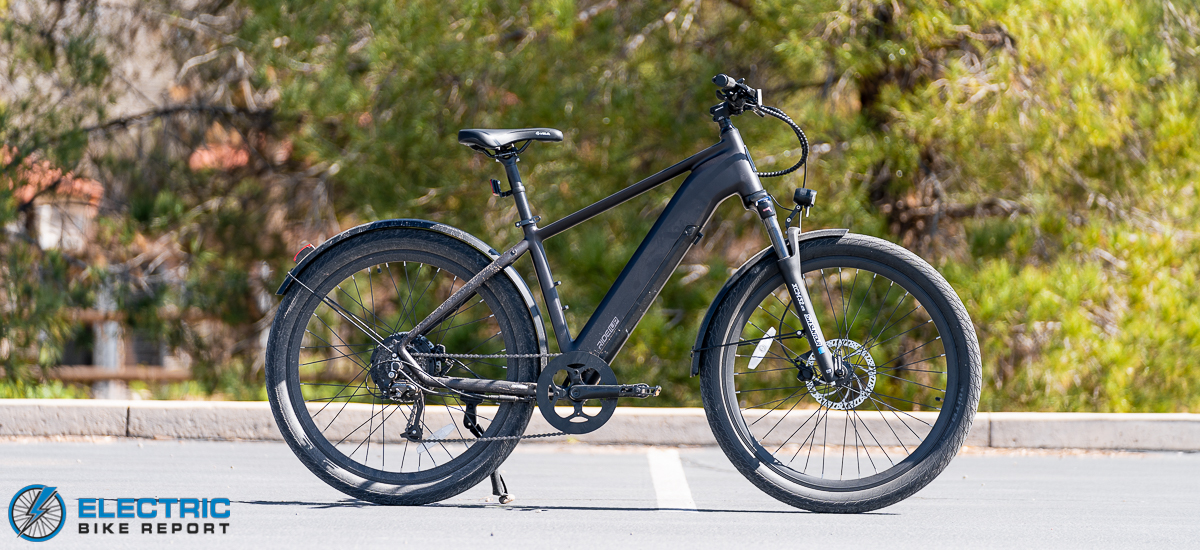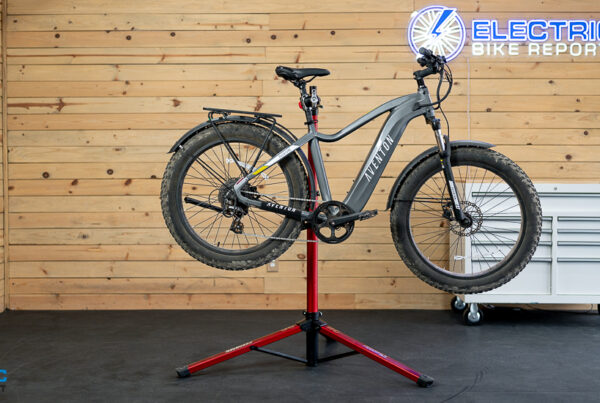

The LMT’D V2 arrived as a Class 2 e-bike with throttle and pedal assist up to 20 mph, though it can be switched to a Class 3 through its settings menu. This grants access to pedal assisted speeds up to 28 mph (the throttle remains limited to 20 mph). As such, I performed a Speed Test in both its Class 2 and Class 3 modes to measure its maximum speeds in its 5 PAS settings. The data from both tests is graphed above.
Our test course is a flat section of paved bike path with straights and curves. Due to the LMT’D’s use of a torque sensor for motor engagement, I maintained a consistent, casual-to-moderate level of effort so as to observe the differences between settings.
In Class 2 mode, I began the test by pedaling with the PAS deactivated (PAS 0) and reached 10.6 mph comfortably. My speeds increased relatively steadily to 13.5 mph in PAS 1, 15.8 mph in PAS 2, 19.1 mph in PAS 3, and 21.0 mph in PAS 4. With the bike limited in its Class 2 settings, there was no room left to go above my PAS 4 speed; I measured the same maximum in PAS 5.
In Class 3 mode, there was an immediate and noticeable difference in the motor’s output across the full span of assist levels. I once again noted steady increases of speed, with maximum results of 14.8 mph in PAS 1, 18.9 mph in PAS 2, 22.8 mph in PAS 3 and 25.1 mph in PAS 4. Finally, I felt a significant kick upon selecting PAS 5; the bike rocketed to 29.9 mph with its maximum output.
With a 48V, 750W rear-hub motor, the bike’s ability to reach the Class 3 limit in PAS 5 (with some gusto, I might add) was no surprise; this is a powerful motor that is able to draw and use current from the battery quickly. However, I found that the bike’s ride felt much more reserved than I expected in its lower PAS settings than I expected based on its specs. I thoroughly appreciated the bike’s non-electric feel, so this was a pleasant surprise!
In most of my other e-bike reviewsI have had to accept the bike’s programming at face value. In the case of the LMT’D V2, the bike’s settings menu allowed me to observe the programmed limits of the motor in each PAS setting. 4 of its 5 assist levels were reserved in their power limits; PAS 1 was limited to 14% of the motor’s maximum output (4 amps of current at 48 volts, or 192 W), while PAS 4 was set to 50% (13 amps at 48V, or 624 W) with PAS 2 and 3 falling between. PAS 5 gained access to 100% of the motor’s power.
With this data visible, the bike’s feel made sense; in all but PAS 5, it felt a great deal like a regular, non-electric bike – just faster. To be clear, I enjoyed the full extent of the motor’s power, and I found even the low power of pedal assist in PAS 1 to be quite effective and fun for casual riding.
We noticed some unusual power surges at times with both the throttle and PAS; the bike would sometimes rush to approximately 24 mph in Class 2 mode before settling down to a lower cruising speed.
Otherwise, the throttle also seemed well-balanced, with steady and vigorous acceleration that felt powerful without being too punchy.
In terms of the distribution of power and speed throughout the Class modes and PAS settings, I think Ride1UP struck a decent balance. The LMT’D did feel somewhat limited in its Class 2 mode with PAS 4, and 5 yielding roughly the same speeds. But this is not unusual on e-bikes that have the ability to switch between Classes. In Class 3 mode, the bike’s power distribution seemed extremely well balanced.
Had that not been the case, however, the point would have been moot; users can completely customize the bike’s programming through its settings menu. It is possible to choose between 3, 5, 7, and 9 assist levels, and the power output can be adjusted within each PAS setting to tailor the feel of the ride to personal preference.
.
.
.
#Ride1UP #LMTD #Review #Electric #Bike #Report
Source link








